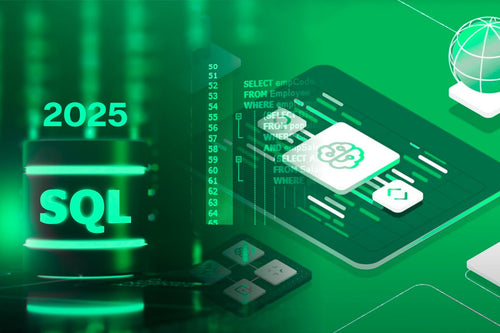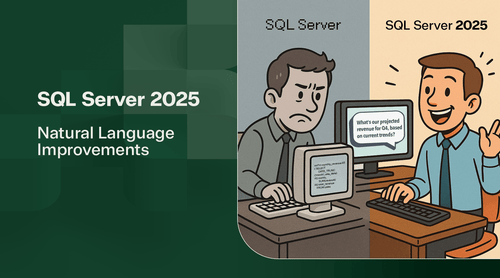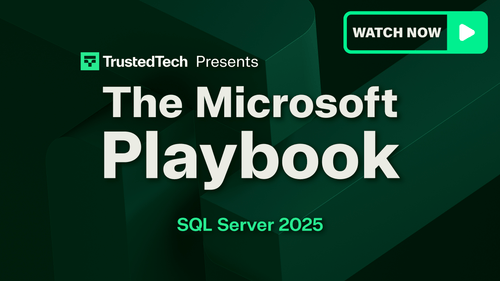SQL Server 2025 greatly enhances developer productivity by integrating AI into the development workflow and supporting modern programming frameworks. Database developers can now leverage AI to write, optimize, and understand T-SQL code more easily. Key new features and tools include:
- Copilot in SQL Server Management Studio (SSMS) – A built-in AI assistant (powered by GitHub Copilot) that accepts natural-language prompts to generate or refine T-SQL queries and explain database schema. Developers can ask Copilot questions about their database or request it to write a query, and it will respond with context-aware suggestions. This works within SSMS's new Copilot chat window, making query building as simple as having a conversation.
- Integration with AI Frameworks (LangChain & Semantic Kernel) – SQL Server 2025 supports popular AI orchestration frameworks, such as LangChain and Semantic Kernel , directly within the database engine. This means you can orchestrate complex AI workflows (such as Retrieval-Augmented Generation, text summarization, or classification tasks) in T-SQL, chaining together prompts and vector searches without leaving the database environment.
- Prompt Engineering and NLP Tools – The platform provides support for crafting and utilizing effective prompts for large language models, as well as understanding natural language queries. In practice, the database can help translate an English question into an optimized SQL query and vice versa. For example, you might write a prompt in T-SQL to instruct an external model to interpret a user's question, all within a stored procedure.
- dbForge Studio AI Assistant (3rd-party) – Microsoft's ecosystem is also embracing AI. Devart's dbForge Studio, a popular SQL development tool, has introduced an AI Assistant that converts natural language to SQL queries, optimizes existing code, and even explains errors. While not a built-in feature of SQL Server, it highlights how tools used by SQL developers are leveraging AI, complementing SQL Server 2025's native capabilities.
Why it matters: These AI-powered developer tools make database development more accessible and efficient. Instead of writing complex SQL commands from scratch, a developer can describe the needed result in plain English and let Copilot generate a starting query. This lowers the barrier for less-experienced team members and speeds up tasks for experts. Integration with frameworks like LangChain enables you to build intelligent applications (for example, a chatbot that queries the database) without switching between different programming environments, allowing the logic to reside within the database. In short, SQL Server 2025 transforms the database into an active partner during development, not just a passive data store.

AI-Augmented Development Examples
Copilot in SSMS: Write and refine SQL queries using plain English prompts
Use case: Imagine a junior analyst who needs to get sales insights but isn't deeply familiar with SQL. With Copilot in SSMS, the analyst can type: "Show total sales by region for the last quarter, and highlight anything over $1M". Copilot will understand this request, generate the T-SQL query to calculate regional sales from the database, and even format the results or suggest a highlight condition. The analyst can then refine the query using Copilot's suggestions (for example, adding a specific filter), all through a conversational interface. Meanwhile, a developer working on an AI-powered app can utilize the integrated Semantic Kernel support to fetch records and feed them into a large language model prompt using T-SQL. This tight integration saves time and ensures consistency because the data doesn't need to leave SQL Server for the AI to work with it.
Integrated Frameworks: Orchestrate AI workflows (e.g., chatbots, summarizers) entirely in T-SQL via LangChain & Semantic Kernel.
Use case: Automated Report Summarization - AI can now summarize reports, dashboards, and performance metrics right inside SQL Server. Instead of scrolling through dozens of tables and charts, users receive concise summaries, such as “Sales increased 12% last month, led by the Northeast region.” LangChain workflows handle the analysis and narrative generation seamlessly, saving hours of manual reporting.
Use case: AI-Powered Data Insights and Recommendations - SQL Server 2025 can act like a smart analyst. Using Semantic Kernel’s orchestration, it combines multiple data sources sales, customer feedback, market data to generate proactive recommendations. For example, “Customer churn risk is rising in Region B; consider targeted offers.” It’s AI-driven decision support built right into your data platform.
Conclusion
SQL Server 2025 marks a turning point in how developers interact with data. By embedding AI assistance directly into the SQL Server ecosystem, Microsoft is transforming database development from a manual, code-heavy process into a collaborative, intelligent workflow. Tools like Copilot in SSMS empower developers and analysts to work faster and more intuitively, turning natural language prompts into precise T-SQL commands. Meanwhile, the integration of LangChain and Semantic Kernel brings AI orchestration and automation directly into the database engine, enabling advanced workflows such as data summarization, retrieval-augmented generation, and contextual insights, all without leaving SQL Server.
These innovations go beyond convenience; they redefine productivity. Whether you’re building AI-powered applications, automating data insights, or simply writing cleaner SQL, SQL Server 2025 positions AI as your coding partner, not just a background utility. As AI continues to evolve, the line between developer and data intelligence will blur even further, and SQL Server 2025 stands at the forefront of that transformation.














